Myko San News
- MYKO SAN DISCOVERY: HOW TO INCREASE THE EFFICACY OF MEDICINAL MUSHROOM EXTRACTS
- 4TH INTERNATIONAL MEDICINAL MUSHROOMS CONFERENCE
- CROATIAN COMPANY INCLUDED IN THE COOPERATION BETWEEN THE EUROPEAN UNION AND CHINA
- 3RD INTERNATIONAL MEDICINAL MUSHROOMS CONFERENCE
- MEDICINAL MUSHROOMS AND MODERN MEDICINE
- MEDICINAL MUSHROOMS AGAINST HEPATITIS C
- MEETING WITH OUR CHINESE PARTNERS
- MUSHROOM EXHIBIT IN ZAGREB
- DEPARTURE OF A PIONEER
- WORLD’S OLDEST MUSHROOM HUNTER?
- MUSHROOMS AGAINST CANCER (2)
- GOLDEN THREAD OF LIFE
- LIVING A LONG AND HEALTHY LIFE
- MUSHROOMS AGAINST CANCER
MYKO SAN DISCOVERS: HOW TO INCREASE THE EFFICACY OF MEDICINAL MUSHROOM EXTRACTS
Setting out to Clarify How Medicinal Mushroom Compounds Affect Cancer Cell Processes, Scientists Unexpectedly Solve a Problem More than 10 Years Old – and the Answer May Be Life-saving.
Keywords: medicinal mushrooms, cancer, extracts, Myko San, research
A team of Croatian scientists led by Professors Drazenka Komes and Ksenija Durgo from the Faculty of Food Technology and Biotechnology of the University of Zagreb, and Dr. Ivan Jakopovich from Dr Myko San – Health from Mushrooms have published an important work in the newest issue of International Journal of Medicinal Mushrooms (Begell House, New York). They have tested medicinal mushroom products on 4 types of human cancers (bowel carcinoma, lung adenocarcinoma, small-cell lung cancer, and brain astrocytoma) and found that they can destroy tumor cells by damaging their membranes and mitochondria, the tumor cells’ ‘power plants’.
Medicinal mushrooms have been used in traditional medicine for thousands of years. Scientific research tested medicinal mushrooms for 60 years. More than 50.000 published scientific papers and 400 clinical trials have conclusively proven that they halt or slow down cancer growth. Several official medical drugs against cancer (isolated compounds PSK/Krestin, Lentinan, Schizophyllan in Japan, and PSP in China) and thousands of dietary supplements from medicinal mushrooms are the results of this research.
The Croatian team was trying to explain the impact of polysaccharides and polyphenol content of medicinal mushrooms on the cytotoxic effects (toxicity to cancer cells), and the mechanisms behind their ability to kill cancer cells. As part of the experiment, the researchers have used both simple extracts from one mushroom species or isolated active compounds (PSP, ImmunoBran MGN-3, and Beta glucan), and complex extract combinations of multiple mushroom species (6 products from Dr Myko San–Health from Mushrooms company, based on the research the company has done with Rudjer Boskovic Institute). Exactly this detail enabled them to solve the problem that has been baffling the scientists for an entire decade.
The scientific community was split into two camps on the issue of extract combinations and their interactions. One side expected the blends to reduce the overall cytotoxic effect by diluting the active compounds and introducing negative interactions. The other maintained that the blends would be more effective, as they would simultaneously influence more processes inside the cancer cells. The preceding research efforts gave mixed results.
This research has conclusively proven that quality medicinal mushroom extract combinations possess much stronger antitumor ability than isolated active compounds. The blends were more effective on all tumor types and stopped the growth of cancer cells, in some cases, better than 100-fold doses of simple preparations. It became obvious why the previous research was ambiguous: the efficacy of medicinal mushroom preparation against cancer is not only determined by the dose of the active ingredient(s), but also by the quality of all components of the blend. Therefore, it’s possible to obtain weaker or stronger results using the blends – and it entirely depends on the quality of the blend.
One of the authors, Dr. Ivan Jakopovich, founder of Dr Myko San-Health from Mushroom company, the first producer of medicinal mushroom preparations in Europe explains:
“Medicinal mushroom extracts show strong antitumor effects and can be very helpful, especially combined with standard cancer therapy. They are ‘chronically’ underused in Western medicine.
Extract blends are superior because they induce synergistic enhancement of active compounds. This leads to reduced tumor cell division and earlier cell death, but also activates more immunological mechanisms in the body.
Medicinal mushrooms work differently than most medical drugs. Their extracts are very effective against cancer, but if we try to increase active compound concentrations and purify them, they start to lose effectiveness. This is probably caused by a great number of still undiscovered active compounds working in synergy, but also by the inertness of inactive ingredients, which do not impair the function of the active ones.
The fortunate thing about medicinal mushrooms is that this huge mix of compounds does not cause negative interactions, so we can get very strong products if we extract them just right. It doesn’t matter that they are not pharmaceutically 100% pure.”
top
![]()
4TH INTERNATIONAL MEDICINAL MUSHROOMS CONFERENCE
Over the past 15 years, the “movement” to research and promote the use of medicinal mushrooms has entered into its “globalization” phase. After the initial international conference on the dietary and health care uses of mushrooms (Hong Kong, 1993) was organized under the auspices of the FAO UN, regular conferences began to be held in the new century (in the Ukraine, Thailand, USA and Slovenia). With each conference, the number of scientists and experts from many countries around the world grows. About 300 participants from some 50 countries around the world took part in the 4th International Medicinal Mushrooms Conference held in Ljubljana, Slovenia in September 2007. Research on the anti-tumor effects of mushrooms is no longer in the forefront, as the phase of proving that “there is something in those mushrooms” has since passed, and it has been established with certainty that more than 300 mushroom species (including single-celled fungi) contain anti-tumor compounds. Nonetheless, a wealth of new findings could be heard about at the most recent conference, held in Ljubljana, Slovenia.
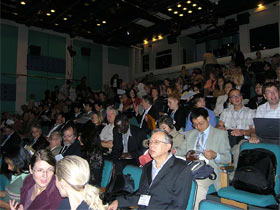
Professor Solomon Wasser, one of the world’s leading mycologists, member of the Ukrainian Academy of Science and Art and head of the Biodiversity and Biotechnology Centre for Cryptogammic Plants and Fungi of the University of Haifa in Israel, held an all-encompassing plenary lecture on ancient traditions, current knowledge and the perspectives of research and the application of medicinal mushrooms. In his lecture, he summarized the main anti-tumor effects of mushrooms and mushroom products: (1) oral consumption prevents oncogenesis; (2) they have a direct anti-tumor effect against various allogenic and syngenic tumors; (3) they strengthen the immunological defense of the body against tumors in combination with chemotherapy, and (4) they have a preventative effect against the formation of metastases.
Professor Wasser also gave a presentation on the patent “Mushroom extracts that act against cancer” that he and his colleagues created and which was accepted in the USA last year. The invention is based on exact indicators that the mycelial extracts of eight mushroom species selectively halt the growth and stimulate apoptosis (natural cell self-destruction) of chronic myeloid and acute lymphatic leukemia, and in hormone-dependent prostate cancer, and also helps in certain forms of anemia. The composition of these extracts can be used in the form of pharmaceutical products, but can also be added to food and beverages. The patent list of the Israeli scientists also contains well detailed methods of treating patients with these illnesses.
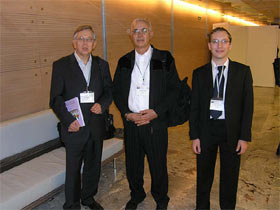
Prostate cancer is the most common form of cancer among elderly men in the USA. It is common in Europe, but rare in Asia. R. M. Hackman of the University of California conducted a detailed study on the effectiveness of the Japanese “Genistein” extract when used in combination with pharmaceuticals to treat prostate cancer. This preparation is made by breeding G. lucidum mycelia on a soy extract substrate. A series of tests conducted on cell cultures confirmed that this preparation strongly halted tumor growth and stimulated apoptosis of tumor cells in both hormone-dependent and hormone-independent prostate cancer. The effect of the combination of this nutraceutical with chemotherapy was substantially higher than the effect of either individually.
Both normal prostate functioning and prostate cancer are closely tied to male hormones, with the androgen receptor playing a key role. As such, the therapy method of removing male hormones in hormone-dependent prostate cancer, even though it still is the most useful therapy for this type of cancer, is of limited value. After a good initial response to the anti-androgen therapy, prostate cancer typically returns in the hormone-independent form, which does not respond to further hormone treatment and chemotherapy.
J. A. Mahajna from the Migal-Galileo Technological Centre in Israel, an associate of Professor Wasser and co-author of the US patent described above, has investigated this issue for years. He and his associates at the University of Haifa tried to find an answer in the large collection of medicinal and edible mushroom cultures there, seeking out compounds that could readjust the functioning of androgen receptors in order to halt the growth of both hormone-dependent and hormone-independent prostate cancer. They tested 201 extracts from various mushroom species and confirmed that 11 extracts had anti-androgen activity greater than 40%. They then used those extracts to treat hormone-independent tumor cells. Extracts of the mushrooms C. comatus and G. lucidum both gave results, though in varying measures, to both types of prostate cancer and to hormone-dependent breast cancer.
Considering that anti-tumor and anti-viral high molecular weight polysaccharides from the best known mushroom species have long since been identified and studied, research has since been directed towards active compounds with a low molecular weight. Large pharmaceutical companies have also expressed their interest in these kinds of compounds. B. B. Yang from the University of Toronto in Canada has looked into whether low-molecular compounds from T. versicolor and G. lucidum, mushrooms proven to have exceptional anti-tumor efficacy, have any influence on breast cancer and lymphoma cells. A series of compounds isolated from these species proved to have strong anti-tumor effects, and should certainly be considered when seeking out the most optimal composition of complex anti-tumor preparations from mushrooms.
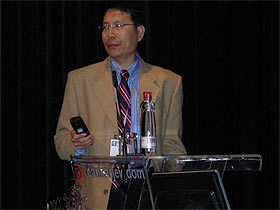
Though they only arrived onto the international scene at a later date, Croatian scientists also participated as equals at this most recent world conference on medicinal mushrooms. Pioneer investigations proved the very strong anti-tumor effects of simple and complex extracts from specific mushrooms on fibrosarcoma, squamosal cell carcinoma and melanoma in mice, extended the life of mice with cancer by what would be analogous to months or years in humans (article published in New York in 2004). In early 2007, a new study funded by the Ministry of Science and Education began to test the anti-tumor effect of some 30 mushroom species and work to define the most effective combination. Some of the tests conducted to date have given surprising and very promising results, but are not yet at the publication stage. Therefore, the research team (M. Jurin, S. Ivankovic and N. Hirsl from the Rudjer Boskovic Institute, and I. Jakopovich from Dr Myko San – Health from Mushrooms) gave a poster presentation in Ljubljana on the main, previously published results, and an overview of the current study.
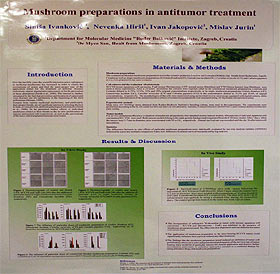
Dr. Jakopovich (Dr Myko San – Health from Mushrooms, Zagreb) gave a presentation entitled Treating Human Cancers with Medicinal Mushroom Preparations (Croatian experience). This was the only presentation dedicated to actual experiences in the use of mushroom extracts with anti-tumor effects. Stemming from the assumption that, although medicinal mushrooms are not a “magic bullets”, scientifically based mycotherapy can be a very significant additional tool in the battle against malignant disease. The author presented the results of the use of the Lentifom and Agarikon complex mushroom extracts in 105 cases of breast cancer and 51 cases of colorectal carcinoma between early 2004 and mid 2007. In the majority of cases, the patients were in an advanced phase, in remission and/or with metastatic cancer. In addition to their standard medical treatment, these patients consumed large doses of these extracts over longer periods of time (on average 40 to 80 days in continuity). The majority of patients were Croatian residents, though some were from BiH, Slovenia and other countries. The analyses of the results are based on official medical records from the hospitals in which the patients received standard oncological treatment.
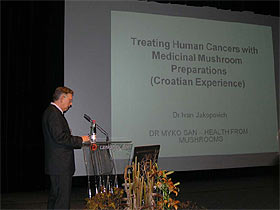
Here we present only the most fundamental indicators of this detailed study. Among the 51 patients with colorectal carcinoma that were included in the study, 60% were in a very advanced phase (stage 4) of the disease. Upon completion of the initial mycotherapy, more than 90% had an unchanged or improved status, and of these almost 45% experienced an improvement in their condition. Especially important is the correlation which clearly indicates that increased consumption led to better outcome. At the end of the study, almost two thirds of the mycotherapy users were still alive, with 80% of those with an unchanged or improved status. It was also found that those included in the mycotherapy had improved tolerance to radiation therapy and chemotherapy, and the appearance of recurrences was reduced.
Of the 105 breast cancer patients included in the study, 53% had undergone surgical removal of the primary tumor, but were suffering from metastasis or recurrence of the disease. Following initial mycotherapy, almost 90% of patients had an unchanged or improved status. At the end of the study, almost two-thirds of patients in the study were still alive. Almost 70% of the surviving patients showed virtually no signs of the disease, while the status of a further 15% was unchanged or improved. In 11%, the malignant processes had spread.
Though this was not a controlled clinical trial, but rather an analysis of data of oncological patients who shared only a diagnosis and who consumed high doses of mushroom extracts over a longer period of time, the results of this study strongly support the conclusion that the use of these extracts is beneficial for persons suffering from malignant disease. Patients taking mycotherapy were less likely to die, they lived longer and had a better quality of life. (see this Powerpoint presentation Treating Human Cancers with Medicinal Mushroom Preparations)
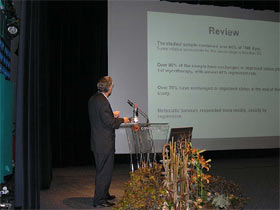
More photographs from the conference
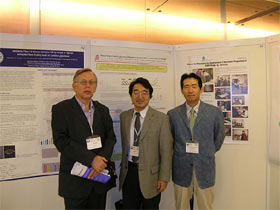
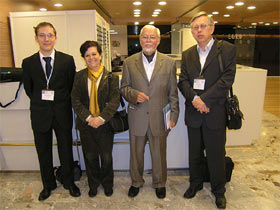
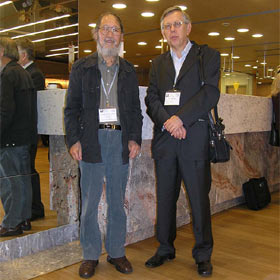
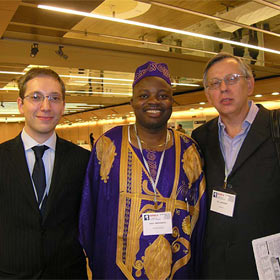
top
A CROATIAN COMPANY COOPERATES WITH THE EUROPEAN UNION AND CHINA
The first conference on the cooperation of biotechnology companies from China and Europe was held in Beijing on 18-19 September 2006. The objective was to promote cooperation, partnership and joint venture projects between the Chinese biotechnology industry and growing small and medium-sized European biotechnology companies and development agencies.
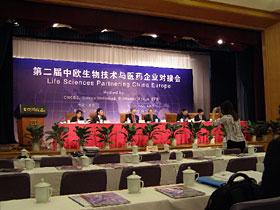
The conference, based on an initiative by the European Commission, was co-organized by Europe Unlimited (Brussels), BioMedico Forum (Aarhus) and the Chinese National Center for Biotechnology Development. Plenary speeches were given by high representatives of the Chinese Ministry of Science and Technology, and the counterpart “ministry” of the European Commission, and several authoritative experts from both sides. They gave an overview of the policies of China and the EU regarding the development of the biotechnology industry, the current state of affairs, potential markets for biotechnology products in China and the EU, and the potential for investment in this field. In terms of development dynamics, this field is developing at a rate second only to the computer industry.
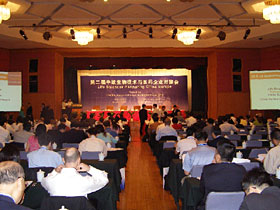
Following the plenary section, representatives from more than 40 European and 90 Chinese companies presented their company activities and potential, and need for cooperation. The second day of the conference was dedicated to direct talks between representatives of the Chinese and European companies that are interested in mutual cooperation and various forms of partnership.
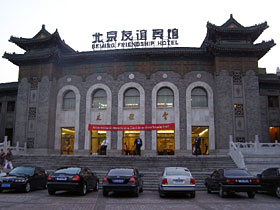
The only company from a non-EU country to be invited to participate in the EU delegation was the Croatian company DR MYKO SAN – HEALTH FROM MUSHROOMS from Zagreb.
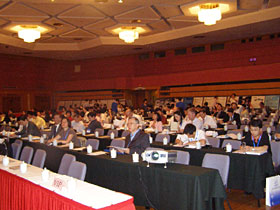
conference opening ceremony
Following the presentation given by company director Dr. Ivan Jakopovich, several representatives of interested Chinese companies met with the Croatian delegation.
The most interesting meeting was held with a delegation from a prominent biotechnology company from the city of Hangzhou. A proposal was made to launch a joint project to manufacture medicinal mushroom products in China for both the Chinese and EU markets. Talks regarding this project are ongoing.
This globally significant project to stimulate cooperation between the Chinese and European biotechnology sectors, which Canada intends to join, was continued in April 2007. The Croatian delegation from the company DR MYKO SAN – HEALTH FROM MUSHROOMS again participated in this conference.
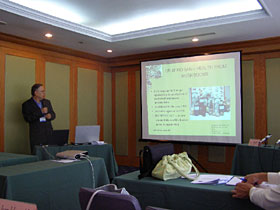
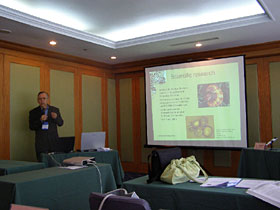
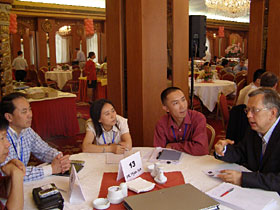
![]()
THIRD INTERNATIONAL MEDICINAL MUSHROOM CONFERENCE
The 3rd International Medicinal Mushroom Conference was held in Port Townsend, Washington State in the northwestern USA from 12 to 17 October 2005. The conference could be considered a world congress, with more than 200 participants from more than 25 countries. When considering all the submitted papers, the number climbs to 250 scientists from 38 countries from all around the world. The newest research on new anti-bacterial, anti-tumor and immunostimulant, anti-allergic, hypolipidemic and anti-viral compounds from medicinal mushrooms, clinical trials, new research in the field of mushroom cultivation, ethnomycology, mushroom poisoning and mycoremediation (remediation/ restoration of the natural environment from pollution using specific mushroom species) were presented in a series of plenary lectures, parallel symposium sessions and poster sessions. Of particular importance, of course, were the questions posed and discussions launched among experts following the lectures, the networking and exchange of experiences.
The organizer and host of the conference was the company Fungi Perfecti, run by Paul Stamets, one of the world’s foremost experts on the cultivation of edible and medicinal mushrooms and the production of mycelia and restoration of forests with the help of mycorrhizal mushrooms. He has authored several world renowned books on these topics. Co-organizer of the conference was Professor Solomon P. Wasser, who launched and co-organized the 1st International Medicinal Mushrooms Conference in Kiev (Ukraine) in 2001, and the conferences that followed, as well as future conferences that have already been arranged. Wasser is currently at the University of Haifa (Israel). Previously, he lived in the Ukraine and worked at the Botanical Institute of the Ukrainian Academy of Science in Kiev and has brought scientists from the former USSR, Israel and Western countries together on a series of projects. He is author of several prominent mycological books in the Ukrainian, Russian and English languages, and is author and co-author of many scientific articles. He is editor-in-chief of the world’s only specialized journal in this field, the International Journal of Medicinal Mushrooms.
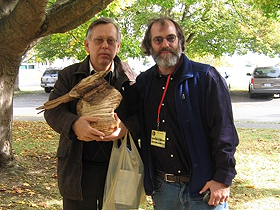
The conference was attended by many internationally renowned experts: Christopher Hobbs, a pharmacologist from the Institute for the Study of Natural Products at Davis, USA, has written several books on medicinal mushrooms and is one of the world’s leading experts on medical properties of fungi; Dr. Shung-Chang Jong is a mycologist from the American Type Culture Collection, one of the world’s largest gene bank and leading authority concerning intellectual property rights and the development of fungal products; Dr. Gaston Guzman is a professor at the Institute for Ecology in Xalapi, Mexico and the leading authority on hallucinogenic and psychoactive mushrooms, and David Aurora, a world-class mushroom hunter and expert in the field of practical ethnomycology, i.e. the collection and use of mushrooms in various traditional communities, and author of prized handbooks for mushroom collecting in the wild.
Two other world renowned names must be stressed. The first is Dr. Shu-Ting Chang, professor at the Chinese University in Hong Kong and one of the leading world authorities on the biology and biotechnology of mushroom cultivation and processing, author of several classical books in this field and promoter of a number of activities on a global scale to promote the cultivation and use of edible and medicinal mushrooms. He celebrated his 75th birthday at the conference, and he gave an inspiring plenary lecture on the need for further development of scientific validation of medicinal mushroom products. He meritoriously stated that the “progress made in the last two decades, both in research and in production, clearly confirms the benefits of medicinal mushrooms for protecting human health.”
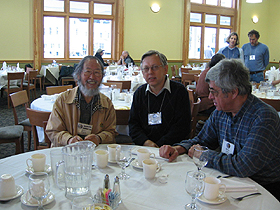
The second living legend in the field, and in attendance at the conference, was Dr. Tetsuro Ikekawa, currently with the Japanese Association for Integrated Medicine. It was almost 40 years ago that he first began systematic research on the anti-tumor properties of mushrooms at the Research Institute of the National Cancer Center in Tokyo. At this conference, he spoke on reducing the risks of contracting cancer with the help of medicinal mushrooms.
Two representatives from Croatia, from the company DR MYKO SAN – HEALTH FROM MUSHROOMS, Dr. Ivan Jakopovich and Professor Dr. Mislav Jurin (researcher in experimental oncology at the Rudjer Boskovic Institute in Zagreb for almost 40 years, and professor of graduate and postgraduate studies in the fields of pharmacy and medicine at the University of Zagreb) participated at the conference.
On our way from Zagreb to Port Townsend, we visited Houston, Texas, where more than 35 years ago, Professor Jurin was on a postdoctoral fellowship in experimental oncology at the M.D. Anderson Cancer Center. Our host was Professor Luka Milas, who has been at the Center for almost 30 years, the head of the Radiology Department for 12 years, and is the winner of the U.S. Radiologist of the Year award in 2004. He gave us a tour of the research laboratory and part of the clinical ”facilities” of this center, which is the world’s largest cancer center and is constantly expanding, like a “city within a city”. The center employs 65,000 people, and treats several million oncological patients each year, making it the second strongest “industry” in Houston, after oil drilling and refining. Despite the center’s massive material and technological strength, investments and profitability, and the enormous scientific and expert potential, the Center primarily operates within the traditional branches of official oncological treatment of cancer patients – cut (surgery), burn (radiotherapy) and poison (chemotherapy).
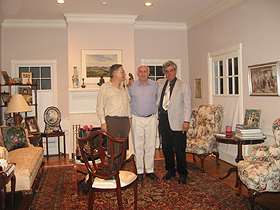
Unlike the large Texas city and highly sophisticated medical industry, the Olympia Peninsula in Washington State, where the organizers took us after picking us up from the airport in Tacoma near Seattle, is made up of huge forest and ancient forest areas that surround small settlements, situated in a deep bay that is open to the Pacific Ocean. Though our destination was the small town of Port Townsend, the conference was actually held just a few miles further, in the facilities of the former Fort Worden military base, and today part of the large Olympia National Park.

The day before the start of the working section of the conference was reserved for mushroom hunting in the ancient forest of the national park. We drove several hours through mountainous regions, mostly covered in forests, and then spent several hours in this “mushroom heaven”, at the peak of the mushroom season, collecting a large number of species for the exhibit that was an integral part of the conference. Several of the most renowned American and world “field” mycologists also participated in the mushroom collecting, such as Gary Lincoff, instructor at the New York Botanical Garden and president of the North American Mycological Association, and author of some of the best known American collecting and identification field guides.
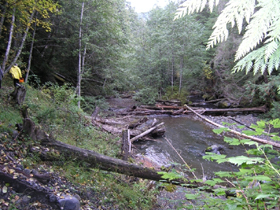
Among the social events organized as part of the conference, the special two-day culinary event led by well known American chef John Pisto is certainly worth mentioning. In a fishing hut on the coast, he prepared fantastic mushroom dishes for about a hundred conference participants. Of course, we must also praise our own promotional success. At the proposal of the organizers, many participants brought wines from their home countries, and a wine tasting was held one evening, followed by a secret vote on their quality. We brought with us a bottle of Enjingi Traminac (Gewürtztraminer) and Milicevic Dingac (a native variety from the island of Hvar). In the secret vote by mycologists and mushroom collectors from all around the world, the Croatian wines took first place for both white and red wines, despite the strong competition.

Many new scientific studies were presented at the conference. Below, we outline only a few.
SELECTED STUDIES
One study entitled Chemopreventive properties of mushrooms against breast cancer and prostate cancer was carried out by a group of researchers (S. Chen et al.) from the Beckman Research Institute in California, USA. The premise for the study was that an abnormal amount of the aromatase enzyme in breast tissue represents a risk factor for the emergence of breast cancer. They confirmed among 7 extracts studied that the one from the well-known button mushroom was the most effective in halting the activity of aromatase. Mushrooms contain several compounds that halt aromatase in a specific way, but these effects are not cytotoxic.
Button mushrooms can also be a chemoprotective agent against prostate cancer, as they contain compounds that hinder the activity of the steroidal 5α-reductase and aromatase, the enzymes that play an important role in the development of prostate cancer and benign enlargement of the prostate. These compounds found in button mushrooms hinder growth and reduce the tumor mass in both hormone-dependent and hormone-independent prostate cancer.
The researchers concluded that consuming button mushrooms could reduce the frequency of breast and prostate cancers. From this, their research is expanding to include the mushrooms Ganoderma lucidum and certain strains of Fomitopsis officinalis, as they also contain compounds that hinder aromatase and steroidal 5α-reductase.
Christopher R. Hobbs prepared a review article entitled “Medicinal value of Trametes versicolor“. This is one of the most investigated medicinal mushrooms. A series of controlled clinical trials have proven that this mushroom increases the long-term survival of patients with stomach, intestinal and other cancers. Extracts of the fruiting bodies and mycelia were most effective when taken orally. In Japan, these products are often prescribed in combination with chemotherapy, and the national health insurance covers the cost.
Extracts from T. versicolor truly have a broad spectrum of immunological effects, and can prevent carcinogenesis and tumor growth, by activating the natural self-destruction (apoptosis) of the cancer cells.
Since 1990, a series of controlled clinical trials on specific extracts from these mushrooms have been carried out in Japan, particularly in the treatment of patients with cancer of the large intestine and colon, as well as stomach, breast and lung cancers. These extracts are taken orally and always in combination with various chemotherapeutics. Some of these trials showed a 10-15% increase in patients’ survival of 15+ years when taking these extracts. Side effects from chemotherapy (e.g. nausea and loss of appetite) were reduced, and the blood tests and body weight were improved.
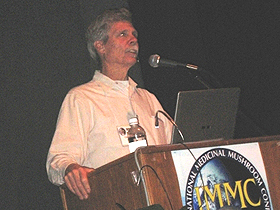
We previously mentioned Tetsuro Ikekawa, the pioneer of scientific research on the anti-tumor properties of mushrooms. He held a very well-received lecture entitled Reducing the risk of cancer using mushrooms and clinical studies on EEM. In the first of two well documented parts of the lecture, he gave an overview of an epidemiological study conducted among professional cultivators of the velvet foot mushroom (Flammulina velutipes) in Japan’s Nagano province, carried out from 1972 to 1986. The study showed that the mortality rate due to cancer among these cultivators was almost half the average cancer mortality rate in that province, and suggested that the use of certain edible mushroom species can efficiently reduce the risk of contracting cancer.
A controlled clinical study was then conducted in the same province, from 1998 to 2002, aimed at finding a better explanation of the relationship between reducing the risk of cancer and the use of edible mushrooms. If the likelihood of contracting stomach cancer in a person who eats virtually no mushrooms is assigned an index of 1.00, then in people eating Hypsizygus marmoreus more than once a week, the likelihood is reduced to 0.57, those eating Pholiota nameko is 0.56, and those eating F. velutipes more than three times a week is 0.66. It is interesting that Lentinus edodes (shiitake) mushrooms, despite having components that to a very high degree halt the growth of already existent malignant tumors, have virtually no effect on reducing the rate of contracting stomach cancer, even when eaten more than three times a week. Ikewawa stated that the studies on anti-tumor effects of mushrooms were carried out in Japan’s National Cancer Center, and that many anti-tumor polysaccharides and protein-bound polysaccharides had been isolated from the mushrooms.
Based on these studies, a new product based on extracts of the mushrooms H. marmoreus and F. velutipes was developed and called EEM (extract of edible mushrooms). EEM was then clinically tested on patients with advanced stages of cancer, and it proved to be better in improving patient malnourishment than the standard drug MPA. A second clinical study with patients with advanced cancer showed that patients receiving EEM in combination with chemotherapy showed a better clinical response, better overall condition and quality of life index than patients who only received chemotherapy. EEM also had a positive impact on pre-cancerous damage to the esophageal mucosal tissues.
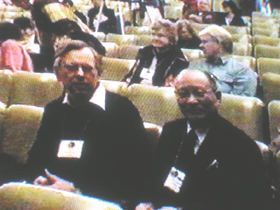
A group of South Korean researchers (Jae-Sung Lee et al.) from the Bioindustry Faculty in Gyongsan and the Institute for Food and Cultivation in Seoul presented the results of their study entitled Hepatoprotective effects of wax brown rice cultivated with Agrocybe cylindracea. The group investigated whether or not this ‘functional’ rice, received from cultivating the mycelia of the black poplar mushroom (Agrocybe aegerita) on wax brown rice as a substrate, has any effect on protecting the liver. In the experiment, they gave rats an extract of this functional rise for 14 days before treating them with carbotetrachloride, a liver toxin. The rats that received only the toxic matter recorded an increase in the level of the liver enzymes AST and ALT, and the liver itself increased in size. The rats that had previously received the functional rice extract showed virtually no change in the size of the liver or liver enzyme levels, which remained at the levels of normal, healthy rats not exposed to the toxic substance.
The rats exposed to the carbotetrachloride had other symptoms of liver damage and disease – an increase in the enzymes ALP, LDH and GGT, a strong reduction in the level of albumin, total proteins and HDL cholesterol, and an increase in total cholesterol and triglycerides in the liver. Contrary to this, rats that had previously received the functional rice extract showed biochemical parameters that were partly normal, or slightly impaired, which clearly proves the protective effect the extract had on their livers. Considering that the rice itself showed no such effect, this activity is evidently from the specific compounds contained in the black poplar mushroom. Very similar results were obtained in an experiment with extracts of wax brown rice cultivated with the mycelia of two Coprinus mushroom species – Coprinus comatus and C. cinereus.
A research group from Israel (Jamal Mahajna, Solomon P. Wasser, et al.) from the Migal-Galilee Technological Center and the Institute for Evolution (University of Haifa) presented the results of their study entitled Compounds from medicinal mushrooms serve as molecular cancer therapy, carried out within the Programme to Discover Anti-Cancer Medicines. While earlier studies paid the greatest attention to the high-molecular weight polysaccharides, this group focused on mushroom compounds with a low-molecular weight, and studied their mechanism of activity. Their focus was primarily on compounds in mushrooms that specifically modulate molecular “targets” included in carcinogenesis, particularly in chronic myeloid leukemia (CML) and prostate cancer.
In standard CML therapy, the drug imatinib is used. This drug halts the synthesis of the protein p210 Bcr-Abl with increased activity of tyrosine kinase. However, in advanced stages of the disease, resistance occurs, and the clinical efficacy of the drug is consistently reduced. The Israeli researchers established that compounds in certain mushroom species initiate the process of apoptosis (natural self-destruction) of tumor cells and erithroidal differentiation of the CML cells, and causes a reduction in the level of the Bcr-Abl protein.
Prostate cancer is the second leading cause of death among men in the Western world. This cancer is primarily hormone-dependent and is treated with hormone therapy. Unfortunately, it soon changes into the hormone-independent form. On the other hand, prostate cancer is very rare in some Asian nations. This has been correlated to the diet in those countries, in particular the consumption of several mushroom species for the prevention of prostate cancer.
Based on that, the Israeli researchers were able to establish exactly that extracts from several mushroom species have a significant effect against prostate cancer. This includes the ability to modulate the androgen receptor, making these compounds from mushrooms efficient in fighting hormone-independent prostate cancer.
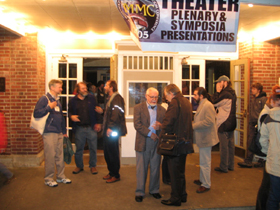
Gaston Guzman and Ivan Jakopovich (center) say goodbye
second on the left is P. Stamets, first to the right is G. Mata
The next, 4th International Conference on Medicinal Mushrooms will be held in September 2007 in Slovenia. At the proposal of Professor Wasser, the Croatian team will also be included on the organizing committee for that conference.
![]()
MEDICINAL MUSHROOMS AND MODERN MEDICINE
On May 22, 2004, the 5th Croatian Congress on Cooperation between Classical and Unconventional Medicine was held within the Medicine and Technology Fair in Zagreb. The Congress was organized by the Croatian Association for Natural, Energetic and Spiritual Medicine (HUPED), under endorsement of the Ministry of Health. HUPED chairman, Vedran Korunic, opened the one-day congress, which featured presentations by more than 20 domestic and foreign participants engaging in various forms of (so-called) unconventional medicine.
A well received presentation entitled Medicinal Mushrooms and Modern Medicine was given by Dr. Ivan Jakopovich, co-founder and director of the company DR MYKO SAN – HEALTH FROM MUSHROOMS. The presentation was published as a paper in the Congress proceedings Quality Cooperation for a Healthier Man.
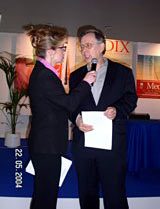
MEDICINAL MUSHROOMS AND MODERN MEDICINE
ABSTRACT: For several millennia, traditional medicine has used medicinal mushrooms in the treatment of various diseases, including cancer. In this field, traditional medicine has accumulated great amount of experience in many countries, such as China, Japan, Korea, Russia and others. For more than 50 years, science has been increasingly dealing with research on the active substances in medicinal mushrooms, the mechanisms of their activity and searching for the most suitable manner of application, either in the treatment of various diseases (infection, cancer, degenerative processes), or for their prevention. This interest of science has been particularly stimulated by the fact that not even now, at the beginning of the third millennium, the prevention and treatment of cancer and certain viral diseases is not at a satisfactory level. Namely, though people are living longer throughout the developed world, the paradox is that the rate of certain diseases in significantly on the rise. The ability of certain fungal components to modulate human immunity, reduce blood pressure and the concentration of lipids in the blood, to hinder the growth of certain tumors and the activity of microbes, reduce inflammation and more, is becoming increasingly important and useful. It is essential that we research extracts from various medicinal mushrooms, and in particular their appropriate combinations, in order to select the best preparations for the treatment or even prevention of various pathological conditions.
KEY WORDS: medicinal mushrooms, modern medicine, cancer, viral diseases, hypertension, hyperlipidemia, diabetes
The use of medicinal mushrooms for the preservation of health and in combating disease, like the use of medicinal plants, is much older than contemporary Western medicine, based on modern science and techniques, and the modern pharmaceutical industry. The oldest official list of medicinal substances (materia medica), Shen Nong Ben Cao Jin, which contains medicinal mushrooms species that today have been scientifically verified, was compiled between 500 and 1,000 years B.C.E., and is based on the classic knowledge of the period of the first known Chinese Emperor Shen Nong from the 29th century B.C.E. For thousands of years, traditional Chinese medicine was China’s official medicine, and influenced the whole oriental region. That is convincing evidence that it is unacceptable, especially lacking expert knowledge, to dogmatically reject the experiences of the folk, but official, medicine of the ancient civilizations, which were carefully followed and confirmed in practice. As was noted by K. Matsumoto, modern Western medicine does not possess medicines that have been used in medical practice for 2000 years or more, on a population of several billion people. For many years, the World Health Organization has also recommended, that in addition to official Western medicine, the use of other (expertly and scientifically) proven experiences and methods from various civilizations and peoples for the preservation of human health. The Constitution of the Republic of Croatia guarantees all citizens the right to health, which necessarily implies the right to be informed about different approaches and possibilities of health protection, and their practical application. This, of course, includes the right to safety and the protection of health, which represents a constitutional defense to the automatic, ill-informed rejection of contemporary scientific and technical medicine, but from its own abuses as well.
Over the past 50 years, the experiences and knowledge of traditional medicine of the properties and use of medicinal mushrooms has been systematically tested by strictly scientific methods: determining the active substances of mushrooms, their chemical composition, and how they work. Research has been carried out on test animals and human cell cultures and clinical studies conducted. The Japanese are at the forefront in this regard, and the Chinese have made significant contributions (though the results of their data are less accessible). However, the Koreans, Russians and others are also taking part, as are Western scientists, led by the Americans. These researchers are active at institutions such as the National Cancer Centre in Tokyo and at leading Japanese universities, where research is usually financed by the Japanese Ministry of Science and Education, and the Japanese Agency for Science and Technology, at the Chinese Academy of Science (its Botanical Institute and others), the Academy of Traditional Chinese Medicine, the Institute for the Testing of Medications and Products of Live Origin, well-known Chinese universities in the People’s Republic of China, Hong Kong and Taiwan, and the National Cancer Institute in the USA, American universities and so forth. Their results have been published in eminent international magazines in the field of medicine (oncology, immunology, virology…), pharmacology, biology and biotechnology. Data on medicinal mushroom research are stored in the world’s leading databases (such as Medline), and many patents have been registered. Since 1999, the specialized International Journal of Medicinal Mushrooms has been published in New York. This journal brings together the world community of researchers in this rapidly growing field.
In 2001, an international conference called “Perspectives of medicinal mushrooms in the protection of health and in the diet in the 21st century” was held in Kiev, with 348 participants from 38 countries. Of course, there is a massive gap between the collection of scientifically confirmed data on the medicinal properties of various mushroom species and their practical application, even though the production of nutraceuticals (food supplements with positive health impacts) is recording rapid growth on a global scale.
It is an indisputable fact that modern scientific and technical medicine is superior in its diagnostics, prevention and treatment of certain infective diseases, as well as the treatment of acute conditions. However, not even now, at the start of the third millennium, has a satisfactory level been attained in the prevention and treatment/curing of cancer, certain viral and chronic diseases. It is in this field that cooperation between modern Western medicine and the scientifically founded use of medicinal mushrooms and their active compounds has arisen, and is expanding, from Japan to the USA.
BETTER SUCCESS IN FIGHTING CANCER
According to data of the World Health Organization, Croatia stands at a terrible third place in the world for deaths from cancer. Cancer in Croatia is the second leading cause of death, immediately behind cardiovascular disease. The situation can stand to improve, not only through the perfection of surgical, chemotherapy and radiation treatments, but through increased use of anti-tumor compounds from medicinal mushrooms as well.
In analyzing the millennia of experience of traditional medicine of the Far East, in recent decades, scientists have proven that certain mushroom species possess anti-tumor properties. Some (Lentinula edodes, shiitake;Coriolus versicolor, Ganoderma lucidum, Grifola frondosa…) contain series of medicinal compounds. The most important of these are polysaccharides, which modify the body’s response. They modify the tumor cells in such a way that our defensive cells can recognize them, and they also naturally enhance the body’s natural strength. Some of these compounds are able to directly destroy tumor cells. Research by Mori, Lucas, Cochrane, Wandokanti, Utzig, Ikekawa, Mizuno, Chihara, Hamuro, Nanba, Xiao-Yu Li and other scientists have proven that polysaccharides and other compounds from medicinal mushrooms show a high or very high rate of inhibiting the growth of various tumors (included metastases), a significant rate of their complete withdrawal if taken early on, and very powerful protection from tumors if taken prior to their emergence.
Shiitake extracts were shown to halt the growth of sarcoma 180 in 80.7% of test animals, with complete regression in 6 of 10 cases. In the same study, the extract from the mushroom C. versicolor inhibited tumor growth at a rate of 77.5%, with complete regression in 4 of 8 cases, while the extract of G. lucidum showed a 98.5% rate of inhibition of tumors, with complete regression in 4 of 5 cases. For some components and doses, the inhibition rate was 100% with complete regression of tumors in all cases.
Further studies have shown that lentinan, krestin and other active compounds from certain mushroom species strongly stimulate the ability of defensive cells (e.g. macrophages, cytotoxic T lymphocytes, K and NK cells) to recognize and attack tumor cells. Through the production of the body’s own gamma- and alpha- interferons, and the activation of a series of other factors of humoral and cellular immunity, these compounds also strengthen the functioning of normal cells and prevent weakening of the immune system. Human clinical studies, both controlled and uncontrolled, and a massive fund of direct clinical experience, predominantly from China and Japan, where three official anti-tumor medications from mushrooms were registered in the 1980s, have shown that anti-tumor compounds from medicinal mushrooms are most effective when used in combination with surgical treatments, chemotherapy and radiation therapy. As such, this approach is dominant in the official use of these medications in Japan and China.
In addition to being virtually harmless, anti-tumor compounds from mushrooms can significantly extend the life of cancer patients, increase the rate of their recovery and survival, improve tolerance to surgery and speed up recovery afterwards, improve tolerance to chemotherapy and radiation therapy and enhance their positive effects, while simultaneously reducing harmful side effects. They also improve overall body condition and the quality of life of cancer patients.
These results are in accordance with the results of research and practical use of fungal compounds with proven anti-tumor effects in Croatia. Our company has long-standing cooperation with the Department of Molecular Medicine at the Rudjer Boskovic Institute in Zagreb. We have tested the effects of our extracts made from several species of mushrooms, and our combined preparations from mushrooms called LENTIFOM and LENTRAM, which have been available on the market as nutraceuticals for several years. In vitro tests have shown that these preparations strongly inhibit the proliferation of all three types of tumor cells tested to date (fibrosarcoma, squamous cell carcinoma and melanoma in mice), while the proliferation of normal cells was not inhibited but actually stimulated. In vivo, the preparations significantly extended the life of test animals with advanced phases of these tumors, and are proven to be completely non-toxic. A scientific report on the research results has already been prepared for publication in an international scientific journal.
Also, we have recently defined a new three-year scientific research project entitled Medicinal Impacts of Fungal Extracts, in which we plan to test possible anti-tumor effects of more than 20 species of medicinal mushrooms that grow or are cultivated in Croatia. We plan to isolate the active components from those mushrooms species for which this has not yet been done. We will also test the effects of our preparations POLYPORIN and SUPER POLYPORIN on tumors, and the effects of possible other efficient combinations of anti-tumor compounds from mushrooms, aimed at selecting the optimal extracts to create an efficacious product ready for clinical testing. We expect to receive support from the Croatian Ministry of Science and Technology to realize this project.
In practical use, our preparations made from medicinal mushrooms, when taken intensively and over longer periods of time as a dietary supplement, have proven to have positive effects in cases of cancer of the breast, large intestine, pancreas, stomach, ovaries, cervix, prostate, lungs, sinuses, ganglioneuroblastoma and astrocytoma, certain types of sarcoma, non-Hodgkin’s lymphoma, acute myeloid leukemia, and metastases of various tumors… We have also established that these preparations greatly improve tolerance to chemotherapy and radiation therapy, and greatly improve overall body condition. These broad experiences certainly deserve comprehensive professional and scientific evaluation.
MORE SUCCESSFUL FIGHT AGAINST VIRUSES
Not even today, at the start of the third millennium, has medicine found a satisfactory solution to combat viral infections. Hundreds of millions people suffer from viral infections such as hepatitis, genital herpes and other herpes strains, AIDS, oncogenic viruses, influenza, etc., and millions die. Vaccinations exist only for certain viruses, while the current methods of prevention and treatment are only partially successful.
This can be improved through greater use of medicinal mushrooms. Thousands of years of experiences of the Far Eastern traditional medicine and modern medicine have shown that compounds from certain mushroom species can largely inhibit the reproduction of various viruses, and provide very strong protection from infection, while being completely harmless. Lentinan, PSK and other compounds from certain mushroom species strongly stimulate many mechanisms of immunological defense, thereby inhibiting the attachment of the virus to the host cell and penetration into the cell, disrupting the inscription of the viral genetic code into the cell, and preventing multiplication of the virus inside attacked cells. That is why the compounds from medicinal mushrooms are used in official medical treatment of hepatitis, AIDS and other viral diseases in Japan, China and other countries.
Testing conducted at 16 Japanese clinics showed that after 4 months of taking certain fungal compounds, chronic hepatitis B virus became inactive in one-third of patients. A double blind study by Lin et al. in China showed similar results, while a study on 355 cases of hepatitis B by Yan et al. confirmed improvements in 92.4% of patients. Chinese clinical reports on the treatment of 70,000 patients suffering from toxic hepatitis with preparations from medicinal mushrooms reported improvements in 90% of patients (Lui, Medical University in Beijing). Soo (from the Mara Institute in Malesia) reported that treatment of hepatitis A, B and C with certain compounds from mushrooms resulted in great improvements or complete regression within 3 months.
Research conducted at the Imperial College of Traditional Oriental Medicine in Japan showed that treatments using mushrooms lead to moderate to substantial improvements in genital herpes after three months (Mosleh).
Tochikura, Suzuki and other researchers have established that some compounds from mushrooms have a very strong ability to block HIV infection. Ebina et al. found that this is partially due to the fact that mushrooms increase the secretion of interferon. Dr. Priestly (Alaska) has successfully treated AIDS patients with extracts from medicinal mushrooms, while Dr. Hughes (California) has HIV positive patients who have become HIV negative after taking medicinal mushroom extracts for a month. Chinese, Japanese and American clinical trials have shown that fungal compounds can significantly improve the condition of AIDS patients. Many scientists believe that long term use of fungal extracts could prevent AIDS from ever developing in many HIV positive persons. Such a use of mushrooms could reduce the frequency of infection by HIV. Clerici, an immunologist, claims that some 30 to 50% of people who come into contact with HIV never become seropositive due to their strong immune status.
Science has also confirmed traditional experiences that certain mushroom species can largely prevent or accelerate recovery from other viral infections – respiratory infections, various forms of herpes, mononucleosis, chronic fatigue syndrome, influenza and (frequent) colds.
We point out two examples from our experience in Croatia:
- A former nurse was diagnosed with hepatitis C in 1999, and the standard 6-month therapy with interferon and ribavirin was not successful. After three months of taking our product MYKOPROTECT in 2000, both subsequent tests for hepatitis C virus were negative. Her health continues to be stable.
- In 1995, several AIDS patients in Italy were given MYKOPROTECT with the assistance of a well-known Zagreb physician. All patients quickly reported improved immunity, and an increase in T lymphocytes.
HEALTHIER BLOOD VESSELS, HEART, BRAIN…
The most common health ailments and leading cause of death in modern man is cardiovascular disease. This is also the leading cause of death in Croatia, and the leading cause of human ailments and suffering, not to mention direct and indirect materials costs. This can also be improved, in several ways, including through increased consumption of specific medicinal mushrooms species.
Millennia of experience of the traditional medicine from the Far East and modern medicine have proven that some mushrooms, such as L. edodes, G. lucidum, G. frondosa, A. auricula and others, improve blood flow and normalize blood pressure, normalize blood lipid levels and balance blood sugar levels. As such, their proper use prevents, slows or alleviates atherosclerosis, which is the fundamental cardiovascular disorder, causing the narrowing of the blood vessels and reduced elasticity, hindered blood flow and decreased nutrition of the tissues and organs, thus leading to a series of diseases, including heart attack and stroke. These medicinal mushrooms are completely harmless and can also accelerate recovery after a heart attack or stroke, and prevent the entire range of cardiovascular disorders, if taken on time.
Eritadenin, germanium, polyunsaturated fatty acids, derivatives of certain ganoderic acids, neutral detergent fibers and chitin fibers found in certain medicinal mushroom species can significantly reduce levels of cholesterol, triglycerides and phospholipids in the blood. This was proven in studies conducted by Kaneda, Tokito, Cochrane, Li Hua Ren, Yamamura, Vasilyev, Tokuda and others. An American study by Stamler et al. proved that a 1% reduction in cholesterol levels reduced the risk of cardiovascular disease by 2%. Suzuki and Ohshima from the National Diet Institute in Tokyo confirmed that shiitake mushrooms reduced cholesterol levels by 7 to 18% after only one week, and the effects can last for up to one year after the mushrooms are taken! It is upon such studies and practical experience that our preparation MYKOMIX is based, and has been successfully confirmed on the market.
Hypertension is one of the most common afflictions of modern man. It damages the interior of the arteries and accelerates the development of coronary atherosclerosis, and is therefore one of the main risk factors for the development of cardiovascular disease (angina pectoris, pre-heart attack condition, myocardial infarction, myocardiopathy), stroke, thrombosis, gangrene, renal dysfunction, sexual dysfunction…
Studies by Arichi, Kubo, Kim, Lee, Rhee, Ying Jianze, Q. J. Yang, Shimizu, Wei Lu and others showed that certain compounds from medicinal mushrooms (germanium, lentinan, tyrosinase…) improve blood flow, expand blood vessels, reduce their loss of elasticity and, in particular, improve blood flow to the brain and coronary arteries. These processes are further facilitated by compounds that act completely naturally and harmlessly as analgetics and anti-convulsants on the central and autonomic nervous system, which further regulates blood pressure. Nucleosides and other derivatives of nucleic acids, such as adenosine, prevent blood clotting (anti-thrombosis effect). Kabir succeeded in significantly reducing blood pressure in hypertensive rats in only 14 days using medicinal mushrooms, and these effects have been clinically proven in humans. A pilot study in China in the late 1980s showed that high blood pressure and high cholesterol in heart patients was significantly improved in 20 to 48% of cases, and after several months of taking mushroom extracts, cholesterol levels were reduced in 68% of cases. Testing in seven Chinese hospitals showed general improvements in 81.8% of patients with cardiovascular disorders. Our experience with the use of our preparation ARMILENT, also proven on the market, corresponds to the above results.
IMPROVE BLOOD SUGAR REGULATION
Some species of medicinal mushrooms can also optimally regulate blood sugar levels in diabetes. With the establishment of a healthier lifestyle, these mushrooms can also help to prevent the emergence and development of diabetes in healthy persons and persons with borderline cases of diabetes. Traditional experiences have shown, and modern studies by Mori, Hikino, Iwami, Satoh, Potron, Sharon and others have proven the hypoglycemic effects of certain mushroom species (C. georgii, L. nuda, P. hidrophylla…). Some active compounds from mushrooms stimulate the secretion of insulin, other reduce the level of blood sugar without secreting insulin, while for some mushrooms species, their hypoglycemic effects have been confirmed, though the mechanism remains unknown. In traditional Chinese medicine, it is a long established practice that blood glucose levels are normalized through the consumption of certain mushrooms species in the diet (primarily shiitake). This has since been confirmed by exact scientific research, though in Europe and America, the observations and findings of experts and scientists have had little practical impact.
In addition to the hypoglycemic effects of reproductive bodies and/or mycelia of certain mushrooms species, it has also been proven that compounds in mushrooms such as ganoderans A and B, lentinan, thiosulfonate and dietary fiber act to reduce blood sugar levels. In test animals, lentinan efficiently prevented the development of insulin-dependent diabetes (type 1), while in non-insulin-dependent diabetes (type 2), the compound LEM caused an increase in the secretion of insulin and reduction of the level of cholesterol, while in humans it led to the normalization of blood sugar levels and the level of glucose secretion into urine. Thiosulfonate inhibited the activity of factors that destroy vitamin B in the body, which regulates the carbohydrate mechanism. Dietary fiber, which can neither be digested nor absorbed, clear the intestines of harmful matter, while also forming an excellent substrate for enterobacteria. This combined effect prevents the emergence and development of diabetes, as well as arteriosclerosis, hypertension and thrombosis.
The immunomodulation and anti-viral effects of certain active compounds from medicinal mushrooms can also have a significant impact on the immunological and viral disorders that contribute to the emergence and development of diabetes. In addition to contributing to normal blood sugar levels, certain mushrooms can also facilitate and enhance other general diabetes regulation measures. All of this can help prevent and reduce the risk of serious and fatal complications resulting from diabetes, such as heart attack, stroke, renal disorders and failure, disorders of the blood vessels in the legs that can lead to gangrene and the need for amputation, disorders of the peripheral nerves, disorders of the eyes that can cause blindness, sexual dysfunction in both men and women, etc.
Our practical experience to date with our preparation DIMEMYKON, which has been on the market for several years, has proven that its inclusion in the diet, alongside medication and other measures, significantly accelerates the normalization of blood sugar levels and represents an excellent contribution to general regulation of diabetes.
Jul 9, 2004
![]()
MEDICINAL MUSHROOMS AGAINST HEPATITIS C
Hepatitis C, rightfully considered to be “as dangerous as AIDS”, is an acute or chronic disease of the liver that is caused by a family of viruses. Considering that nutritional matter are transported to the liver after they are absorbed in the small intestine for processing, deposition and distribution to other organs and tissues through the blood, the liver has a crucial role in regulating the composition of various chemical compounds and cells in the blood. Any disturbances to the structure and function of this very complicated “chemical centre” can have serious or lethal consequences. For this reason, hepatitis C, which is transformed from the acute to the chronic form in 80% of cases, causes approximately 40% of all cases of cirrhosis of the liver and 60% of liver cancer, and is the main indication for 30% of cases requiring a liver transplant.
Globally, hepatitis C is considered one of the widest spread diseases, with approximately 200 million infected, and 3 to 4 million new persons infected each year. It is estimated that there are 80-90 thousand infected people in Croatia. However, the problem is that these figures are much higher in actuality, due to the insidious nature of this disease.
Hepatitis C infections are primarily transmitted through blood and other bodily fluids. Typically, there are no noticeable symptoms in up to 75% of cases. If symptoms do arise in the period from 2 weeks to 6 months after infection, they are usually very non-specific (such as eczema or joint or muscle pain). One can have chronic hepatitis C for up to 20 years, without experiencing any health problems, and the illness is usually discovered only in the final phases, when cirrhosis of the liver or liver cancer has already appeared.
There is no specific vaccination against hepatitis C. Potential vaccines are still in the early phases of multi-year testing, and will not be available on the market for some time, if at all. The problem is that these viruses change and mutate constantly, similar to the HIV, and viruses that cause the common cold.
For these reasons, the treatment of hepatitis C is a very long, complex, expensive and uncertain process. As such, it must not be monopolized in the hands of the omnipotent pharmaceutical companies and health care establishment, and the use of natural products of plant or fungal origin dogmatically excluded in advance.
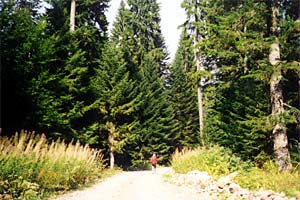
To date, many scientific studies have been published on the antiviral effects of various mushrooms species and individual components within them, resulting in a very wide range of specialized literature. The active compounds in individual species of medicinal mushrooms halt the attachment of various strains of viruses onto host cells, thus inhibiting the process of inscription of the virus’ genetic code into the host cells, and preventing the multiplication of the virus in attacked cells. This is primarily achieved through the activation of a series of immunological defense processes, such as stimulating macrophage activity, stimulating interleukin-1 activity, increase antibody and T-lymphocyte production, more rapid regeneration of bone marrow cells, improved activity of NK cells, etc.
In addition to the above, the shiitake mushroom also significantly increases the production of interferon in the body. For the sake of comparison, today’s famed (and very expensive) pegylated interferons, which in combination with ribavirin can achieve improvement in up to 45% of hepatitis C cases for the genotype 1 virus, acts “like interferon”, i.e. it stimulates the immunological response to the viral infection, and are able to remain active in the body longer than earlier forms of interferon. If the use of proven anti-viral extracts from medicinal mushrooms were to be used in combination with these official therapy methods, the overall results would be much better.
Previously, we mentioned that about 75% of those infected with the hepatitis viruses have no symptoms, and when they do, they are typically mild and non-specific. There is still no specific vaccine in sight, and though it is desirable to avoid risky behavior (drug abuse, unprotected promiscuous sex), it is not possible to block all the paths of transmission of this disease. Our experiences, as shown above in this case, and in our other cases, and in the scientific research suggest that antiviral extracts from medicinal mushrooms should not be taken only by those infected or suffering from hepatitis C, but preventatively for all those exposed to increased risks of contracting the disease, in order to significantly reduce the possibility of contracting this fatal infection. The old saying “an ounce of prevention is worth a pound of cure” may be “worn out” from use, but that does not make it any less true.
Feb 12, 2004
![]()
MEETING WITH CHINESE PARTNERS
On Monday, October 13, 2003, Dr. Ivan Jakopovich, company director, and Marija Jakopovich, director of production, of the company DR MYKO SAN – HEALTH FROM MUSHROOMS visited the ANUGA FAIR, the largest international trade fair for food in Köln, Germany.
The main objective of the meeting was to personally meet the representatives and discuss how to improve the cooperation between our company and the company BAIXING FOOD CO. from China. Our initial contact with this company, from whom we had previously obtained dried mushrooms, as raw material for the production of our medicinal mushroom preparations, was via the Internet. General director Wu Qiyao contacted us, announcing their participation at the ANUGA Fair and invited us for a meeting.
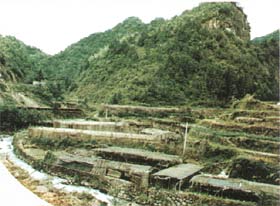
BAIXING FOOD Co. is seated in the town of Qingyuan, in the southeastern Chinese province of Zhejiang. It is a mountainous region without any significant industry, and is known far and wide for its vast forests and abundance of clean air and water. The area is also climatically very suitable for high quality cultivation of edible and medicinal mushrooms. Therefore, it comes as no surprise that this was the first site of cultivation of the shiitake (Chinese name Siang gu) mushroom, according to reliable historical records, in about 1000 C.E. This young and dynamic company bases its organic cultivation of shiitake and other mushrooms on this thousand-year old tradition and experience. The Qingyuan Shiitake mushrooms have also received protected origin status. The meeting between our company representatives was held in a warm and friendly atmosphere, and the end result was an agreement to expand and improve our cooperation.
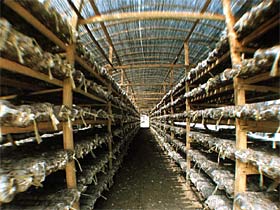
We visited many exhibits at the fair, including several other Chinese stands and one Canadian company for the production and trade of mushrooms and mushroom products. We were kindly invited to visit the stand of the second company from the Chinese province of Zhejiang QINGYUAN COUNTY ZHENCHANG INDUSTRY BUSINESS Co., which also produces various species of edible and medicinal mushrooms. We had a pleasant discussion with company director Lin Liming and his associate, and exchanged basic information about our product program and opened the possibility of establishing corporate cooperation.
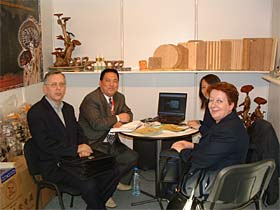
Nov 3, 2003
![]()
MUSHROOM EXHIBIT IN ZAGREB
A mushroom exhibit was prepared by the Kamilo Blagaic Mushroom Collectors Society and displayed at the Student Centre in Zagreb from 24-26 October 2003.
Despite the poor autumn conditions for mushroom collecting, the dedicated members and other associates of the Society, that celebrated its 20th anniversary earlier this year, succeeded in collecting more than 400 mushroom species! The colorful exhibit included representatives of all the “main” families of poisonous, edible, medicinal and other (“higher”) mushrooms.
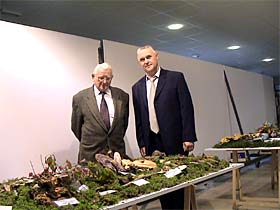
More than 2000 visitors viewed the exhibit, though the media, obviously oblivious to its significance and attractiveness, gave stereotypically “thin” reports. However, there should be no doubts that the mushroom collectors will enthusiastically continue with their work.
Nov 3, 2003
![]()
DEPARTURE OF A PIONEER
Late last year, after a long and difficult struggle with a serious illness, Vojislav Jurlin BSc, one of the pioneers in the cultivation of medicinal mushrooms in Croatia and former Yugoslavia, passed away in his 80th year.
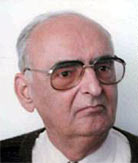 Born in 1922 on the island of Prvic, he was left fatherless at the age of three, and moved with his mother to the outskirts of Subotica. As a secondary school student in Zemun, he joined the progressive leftist youth, and fought with the partisans from 1942 on. After the war he studied electrical engineering in Zagreb, where he settled permanently. He spent a great deal of time, however, “in the field” across all of the former Yugoslavia, leading a team from the Nikola Tesla Company (where he spent most of his career) installing telephone exchanges. Although he was never a field mushroom collector, he only took on mushroom cultivation intensively after entering retirement.
Born in 1922 on the island of Prvic, he was left fatherless at the age of three, and moved with his mother to the outskirts of Subotica. As a secondary school student in Zemun, he joined the progressive leftist youth, and fought with the partisans from 1942 on. After the war he studied electrical engineering in Zagreb, where he settled permanently. He spent a great deal of time, however, “in the field” across all of the former Yugoslavia, leading a team from the Nikola Tesla Company (where he spent most of his career) installing telephone exchanges. Although he was never a field mushroom collector, he only took on mushroom cultivation intensively after entering retirement.
We met some twenty years ago, when I had brought a specimen of the shiitake mushroom from our initial cultivation to a mushroom exhibit. The first exchange of information and experience was followed by years of friendship and collaboration. Jurlin greatly encouraged our interest in medicinal mushrooms, and orientation to their practical use.
He acquired the first posts seeded with shiitake mushroom mycelia and the first strains of the mycelia of this miraculous mushroom from the USA in the late 1970s and early 1980s. Witness to the pioneering significance of his work is the fact that the mushroom culture bank established in Ljubljana by Professor Aleksa Cimerman, PhD, the only such institution in the former Yugoslavia and a part of the European network of similar culture banks, received all of its first strains of the shiitake mushroom back in the early 1980s as a gift from Jurlin!
Vojislav Jurlin had an active or passive knowledge of 9 foreign languages (including “exotic” languages such as Hungarian, Swedish, and Dutch), and he communicated with cultivators and experts from all quarters, travelling to Germany, the Netherlands, Italy and especially Hungary to exchange and collect experience. He collected a fund of literature on the cultivation of mushrooms, shiitake above all. American, Sino-American, Japanese and German monographs, anthologies from international symposia on mushroom cultivation, mushroom characteristics and their products, some still unpublished German doctoral dissertations on the cultivation of the shiitake mushrooms, magazines and articles treating this field of study, from the USA to China and Japan… Unselfishly he lent literature and gave copies to all those interested, and was tireless in encouraging practical work on the cultivation of mushrooms.
Jurlin produced mycelia of the shiitake mushroom and the oyster mushroom. He supplied the “first wave” of cultivators of these mushrooms in Croatia, and also instructed them and oversaw their work, collaborating in various ways with the more independent of them. He himself experimentally cultivated shiitake mushrooms, and constantly promoted their cultivation. With this in mind, he wrote basic brochures on the cultivation of the shiitake mushroom on wood and on substrates, which were circulated as copies and helped many make their first steps. The history of the cultivation of medicinal mushrooms in Croatia would truly be unimaginable without the contribution made by Vojislav Jurlin.
Feb 24, 2003
![]()
WORLD’S OLDEST MUSHROOM HUNTER?
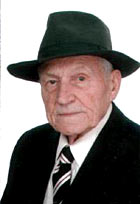 Dr. Josip Jirkal, one of the most active members of Zagreb’s Kamilo Blagaic Mushroom Collector’s Society since its inception 20 years ago, has celebrated his 90th birthday. Since he started picking mushrooms at the age of 5, in the Czech Republic with his grandparents, where he and his family spent the first years of World War I, he is certainly one of the oldest active mushroom collectors in the world!
Dr. Josip Jirkal, one of the most active members of Zagreb’s Kamilo Blagaic Mushroom Collector’s Society since its inception 20 years ago, has celebrated his 90th birthday. Since he started picking mushrooms at the age of 5, in the Czech Republic with his grandparents, where he and his family spent the first years of World War I, he is certainly one of the oldest active mushroom collectors in the world!
He was born in Zagreb in 1913 to a construction businessman. Upon his return from the Czech Republic, he lived, received his education and worked in Zagreb, first as a trained textile technician, and later in the textile business. He saved up to study medicine, and completed his studies at Zagreb’s Faculty of Medicine. He worked as the head of the hematological laboratory at Sveti Duh Hospital, and spent most of his medical career at the Medvescak Public Health Clinic as a specialist of occupational medicine (dispensaries at the Zagreb Oil production plant, the Nada Dimic Company and others).
As a young man, he was both recreationally and competitively active in cross country skiing and ski jumping, and remains an active angler, hiker and mushroom collector.
Dr. Jirkal has spent long hours in the field in Croatia and the Czech Republic, and has come to know a truly extensive number of mushroom species. In the process, he was also a passionate photographer, and now has a collection of about 2,000 slides of mushroom photos. His mycological library, with an abundance of personal margin notes, includes more than 200 books, including most of the classics – in Croatian, Czech, German, French, Italian, Russian, English, Slovak and Polish. For many years, he followed the Czech and Slovak mycological journals, and was fortunate enough to have met and exchange experiences with some of the internationally renowned Czech mycologists – Svrchek, Smotlach, Hlavachek, Hering, Pouzal, Semerdzijev and Kotlabo.
During his impressively lengthy career, Dr. Jirkal has come to know and study a great number of the most frequent families and genera of macromycetes, with a very great number of their species, particularly the edible, poisonous and hallucinogenic mushrooms. It is truly a pity that he has not crowned his research of poisonous mushrooms and mushroom poisoning with a monograph on the subject.
Still active, Dr. Jirkal is preparing a lecture, soon to be held before the Kamilo Blagaic Mushroom Collector’s Society, on the most interesting spring species of mushrooms from the genera Morchella and Helvella. I hope that we will have many more opportunities to have the honor of meeting with him in the field, and trying to keep up with him.
Feb 24, 2003
![]()
MUSHROOMS AGAINST CANCER (2)
One of the world’s leading medicinal mushroom experts, and a pioneer in the scientific research into their medicinal qualities, the late Professor Takashi Mizuno, published an article entitled “The Extraction and Development of Anti-tumor Active Polysaccharides from Medicinal Mushrooms in Japan” (IJMM, no. 1/1999) in the only specialized journal in the field, the International Journal of Medicinal Mushrooms. He was also one of the founders and editors of the journal. The article states that now, at the turn of the 21st century, it is clear, that satisfactory preventive and medicinal agents to fight cancer had not been developed, in comparison to vaccines and antibiotics used to combat pathogenic microorganisms. That is why more and more attention is being dedicated to the development of immunotherapeutic agents, able to identify and eliminate cancer cells, whether preventively – in emergence, or when the disease has already appeared and/or reached advanced stages.
The Japanese market has long had three carcinostatic (immunotherapeutic) preparations developed from mushrooms (since 1977, 1985 and 1986). They were preceded, and in an even greater measure followed, by numerous studies of the chemical composition and effects of the anti-tumor substances derived from mushrooms. Basic research is usually carried out on test animals, implanted with the sarcoma 180 tumor (or some other tumor). One group received the mushroom derived substance under investigation, and the other did not. After a given period of time, the rate of tumor growth inhibition is determined, i.e. in what percentage the tumors of those animals that received the mushroom derived substances are smaller, i.e. lighter, if these substances inhibit tumor growth in relation to the control group that was not treated with the mushroom derived substances. It is also determined in how many cases there was complete regression, i.e. complete disappearance of the tumor in animals treated with the mushroom extracts. Some studies additionally determine how much the lives of test animals with cancer are extended, and/or the rate of mortality of these animals at the end of the experiment. Efforts have been made to determine the results of individual components derived from mushrooms, in order to identify the most effective ones. The standard for evaluation of the effectiveness of an anti-tumor active substance is based on the rate of tumor growth inhibition, i.e. what percentage of tumor growth inhibition a given substance demonstrates: 0-25% – no effect, 26-50% – low effectiveness, 51-75% – effective, 76-95% – very effective, and 96-100% – exceedingly effective.
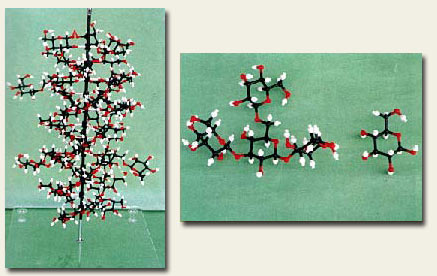
(Marchessaault et al., 1980)
Below are the results from the above-mentioned research article on the anti-tumor effects of various substances from the fruiting body of the mushroom species Ganoderma lucidum (Japanese: Reishi, Chinese: Ling zhi) and Grifola frondosa (Japanese: Maitake).
Table 1: Anti-cancer polysaccharides from the fruiting body of Ganoderma lucidum
| Component from the fruiting body | Rate of tumor inhibition (%) | Complete tumor regression | glucan molecule |
| Control | 0 | 0/5 | |
| FI-1-a | 100 | 5/5 | ß-glucan |
| FA-1-a | 100 | 5/5 | acid ß-glucan |
| FII-1 | 100 | 5/5 | acid heteroglucan |
| FIII-1-a,b | 85 | 3/5 | acid heteroglucan |
| FIII-2-a,b | 100 | 5/5 | heteroglucan |
| FIII-3-a | 100 | 5/5 | heteroglucan |
| FIV-2 | 66 | 2/5 | ß-glucan |
| FV-1 | 95 | 5/5 | chitin |
| SFV-2 | 100 | 5/5 | chitin |
Table 2. Anti-cancer polysaccharides from the fruiting body of Grifola frondosa
| Component from the fruiting body | Rate of tumor inhibition (%) | Complete tumor regression | glucan molecule |
| Control | 0 | 0/5 | |
| FI-a-α | 84 | 4/5 | ß-glucan |
| FA-1-a-ß | 100 | 5/5 | acid ß-glucan |
| FII-3 | 100 | 5/5 | xyloglucan |
| FIII-1-a | 88 | 4/5 | heteroglucan |
| FIII-2-c | 100 | 5/5 | heteroglucan |
Both species of mushrooms tested have been studied many times by different and independent teams of researchers, not only in Japan and China, with mostly similar results. It is evident from the cited data that they contain substances that exceedingly effectively inhibit tumor growth (with rates as high as 100%), with stunningly frequent complete regressions of the tumor. That is precisely why both species of mushroom have been included in the raw material sources used to make our latest anti-tumor preparation SUPER POLYPORIN, now available on the market.
Dec 11, 2002
![]()
GOLDEN THREAD OF LIFE
The preservation of biological diversity is also of great global importance to medical science, despite all the potential of genetic engineering. Although a great number of today’s medicines originate from wild plants, microorganisms, animals and mushrooms, medical science has still only tapped into a very small part of the existing biological diversity. This has been stated by Edward O. Wilson, one of the world’s most influential scientists (and two-time winner of the Pulitzer Prize), in his latest book The Future of Life (New York, 2002), in his passionate appeal for quick and decisive action to save the biological heritage of our planet and offering a plan on how to save it.

And while, for example, the turnover of exclusively herbal medications available for sale in the USA in 1998 amounted to 20 billion dollars, and as much as 84 billion dollars worldwide, this is only a fraction of the total potential of the world’s natural sources. Just how narrow our knowledge and use of natural sources remains was illustrated by Wilson through the example of fungi from the class Ascomycetes (sac fungi) in the control of bacterial diseases. Although only about 30,000 species of Ascomycetes have been studied, and they make up 2% of the total known number of organisms, 85% of antibiotics now in use are derived from them. This inadequate exploitation is even greater if one takes into consideration that perhaps less than 10% of all the species of Ascomycetes in the world have even been discovered and given scientific names. The situation with flowering plants is similar: even though probably over 80% have already been given scientific names, the alkaloids of only 3% of them have been studied. Alkaloids are natural substances that have been shown to be among the strongest medicinal agents in fighting cancer and many other diseases.
Pharmacological abundance in wild species has solid evolutionary causes. Over the history of the living world, all organisms developed chemical substances that prevent cancer in their own bodies, to kill parasites and to oppose predators. The process of mutation and natural section, which have created all of these armaments, are in fact processes of countless trials and errors. Hundreds of millions of species, evolving through the lives and deaths of an astronomically enormous number of organisms during the past geological periods in the Earth’s history, have created the current winners in the mutation-and-selection lottery.
We humans have learned to use these natural sources of health, and they make up a large part of our own pharmacopeia. We have this “wild” biological diversity to thank for the antibiotics, fungicides, malaria medications, anesthetics, analgesics, blood thinners, agents that encourage blood clotting and agents that prevent clotting, stimulants and regulators of the heart, agents that weaken immunity and agents that strengthen it, hormone “imitators” and “inhibitors”, cancer-fighting medications, drugs that fight fever and reduce elevated temperatures, medications to fight inflammations, contraceptives, diuretics and antidiuretics, antidepressants, muscle relaxants, sedatives and many other substances we now have at our disposal. Mushrooms make up an important part of these. In light of the cited examples of just how weak our knowledge and use of this priceless treasure of life on Earth is, we can hardly imagine what kind of miracles and precious substances are still hidden from us.
Sep 23, 2002
![]()
LIVING A LONG AND HEALTHY LIFE
Imagine getting an offer that guarantees you an extra decade or more on your current life expectancy – currently about eighty years – and with excellent health! The offer is realistic, of course, on one condition: you have to add certain medicinal mushrooms to your diet. So argues French physician Bruno Donatini, a gastroenterologist, oncologist and immunologist, who worked in the pharmaceutical industry, where he studied the side effects of drugs, epidemiology and the pharmacoeconomy.
In 1996, Donatini and his colleagues, physicians, pharmacists and lawyers founded the Association for Medical Information, with the aim of providing the general public with impartial and accessible information on the various possibilities in healthcare. Besides contemporary allopathic medicine and its healing possibilities, the association gives due attention to preventive and complementary natural medicine. Which is why Donatini, along with many of his books, also published a book on medicinal mushrooms in late 1999, called Les vertus médicinales de champignons, a small popular science booklet firmly based on more than 300 bibliographic references from original scientific literature from around the world.
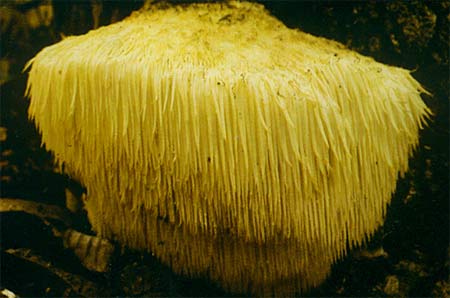
What is the author’s offer of a longer and healthier life with the help of medicinal mushrooms based on? It is based on their scientifically and in practice proven effectiveness in fighting the main groups of diseases of modern man.
- Heart and cardiovascular disorders: elevated cholesterol levels, high blood pressure, smoking… speeds up the process of the atherosclerosis of blood vessels, the creation of fatty deposits (atheroma) and the hardening of the arteries, especially coronary (those that lead to the heart) and those that lead blood to the brain (two in the neck and two in the vertebra). The flow of blood is increasingly hindered and can lead to heart attacks and strokes.Some mushroom species are very powerful agents in fighting high blood pressure, cholesterol, infections and weakened immunity. They are, for example, the Reishi mushroom (Ganoderma lucidum), Hen of the Wood’s (Grifola frondosa), the oyster mushroom (Pleurotus ostreatus) and others.
- Cancer and infectious diseases (viral and bacterial): Some mushroom species have powerful anti-tumor effects, both preventive and therapeutic, and in combating viruses and bacteria harmful and dangerous to humans. Shiitake (Lentinus edodes), turkey tail (Trametes versicolor), Hen of the Wood’s (Grifola frondosa), velvet stem (Flammulina velutipes) and many others strengthen and “adjust” immunity, and can as such greatly reduce the risk of malignant disease and infections, but also fight them effectively when already present.
- Allergies: by not only strengthening, but by also “adjusting” (modulating) immunological reactions, certain medicinal mushrooms help the human body avoid or alleviate pathological oversensitivity to allergens with which we come into contact on a daily basis, and which appear in the form of asthma, eczema (dermatitis), urticaria (nettle rash) and so forth.
- Dementia: mushrooms that regulate blood pressure and fat levels prevent atherosclerosis, which is the chief cause of a weakening of the brain and the deterioration of mental functions. The lion’s mane mushroom (Hericium erinaceus) contains substances that facilitate the synthesis of the nerve growth factor (NGF), which improves the function, extends the life and quickens (partially) the regeneration of nerve cells in the brain and the peripheral nervous system. In some mushrooms, such as, for example, the Reishi mushroom (Ganoderma lucidum), substances have also been discovered that could be useful in fighting Alzheimer’s and other neurodegenerative diseases.
The promise made by Dr. Donatini at the beginning of this article is, evidently, not an empty one. A very effective mycotherapy program can be created using medicinal mushrooms and high quality products derived from these mushrooms for a long and healthy life.
Jun 24, 2002
![]()
MUSHROOMS FIGHT CANCER
An international conference entitled The Perspectives of Medicinal Mushrooms in Preserving Health and Nutrition in the 21st Century was held in Kiev (Ukraine) in September 2001. 348 scientists and experts from 38 countries took part, among them most of the best-known medicinal mushroom experts. The conference was organized by the Ukrainian National Academy of Sciences and the country’s ministries of education/science and health, with sponsors from around the world from research and expert institutions and organizations, to interested companies.
The three-day event saw four honorary and 16 general lectures, as well as 7 theme symposiums in which participants gave about 150 presentations on various research into medicinal mushrooms.
The first honorary lecture, on the useful effects of edible and medicinal mushroom on preserving health, was held by Professor Tetsuro Ikekawa, one of the pioneers of scientific research into medicinal mushrooms, who also presided over the conference. He reminded that research on the anti-tumor effects of mushrooms (Basidiomycetes) began back in 1966 at the Research Institute of the National Cancer Centre in Japan, and is now carried out around the world. After anti-tumor effects were determined in some mushroom species (Trametes versicolor and Phellinus linteus), they began researching how the extracts of some edible mushrooms work on sarcoma 180: it was demonstrated that they were powerful inhibitors of this very malignant tumor!
Further research established that the anti-tumor substances in mushrooms were, above all, certain polysaccharides. One of these is lentinan, isolated from the edible mushroom Lentinus edodes (shiitake). It has been in clinical use in Japan for more than 15 years.
Powerful anti-tumor substances have also been discovered in the edible velvet stem mushroom (Flammulina velutipes). These substances have also been shown as particularly useful in combination with surgical operations and other anti-tumor therapies (chemotherapy and radiation). An epidemiological study carried out in one Japanese region demonstrated that farmers whose chief occupation is the cultivation of F. velutipes are much less prone to dying of cancer than the rest of the population.
Cancer prevention effects have also been determined in other edible mushrooms. Hypsizygus marmoreus is cultivated and popular in Japan, and acts preventively against metastasis. Like Lentinus edodes and Flammulina velutipes (and some other species of mushroom), Hypsizygus marmoreus also has a general preventive effect, i.e. it significantly reduces the risk of a healthy organism from getting cancer.
Cancer fighting mushrooms work above all by improving the body’s immunological response. That is why, Professor Tetsuro Ikewawa concluded, the use of mushroom has been proven effective in protecting from cancer and in fighting cancer when it already appeared.
Jun 7, 2002
![]()
